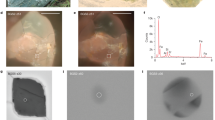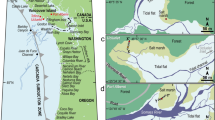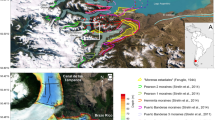Abstract
A LATE Weichselian geomagnetic reversal has been reported1,2 from Sweden. Mörner and Lanser3 believed the Swedish reversed palaeomagnetic record to be a “real dipole magnetic reversal of greatest significance for global correlations” and to have been established and well dated in Canada, the North Atlantic and New Zealand and tentatively recognised in Czechoslovakia, the Northern Pacific, the Gulf of Mexico, Japan and France. Noël4 has described further palaeomagnetic results from two Swedish varved-clay cores as accurately tracing the annual behaviour of the geomagnetic event and delimiting its initiation and termination. Recognition of the event in lavas and deep sea, continental shelf, varved-clay and lake sediments has been cited as confirming the reality of the event. That previous research, particularly in Sweden, has concentrated on palaeomagnetic measurements at numerous, different late Weichselian localities. Because of the difficulties in correlating between localities, interpreting palaeomagnetic records in coarse grained sediments and deciphering coring and sedimentological complexities in single cores, we have instead studied one carefully selected site in detail. We have come to the conclusion that Swedish late Weichselian palaeomagnetic data do not record a reversal or excursion of the geomagnetic field, but demonstrate that the Swedish geomagnetic field has been of normal polarity since 13,000 yr BP. The Swedish late Weichselian reversal had thus become an example of Watkins'5 “reinforcement syndrome”.
This is a preview of subscription content, access via your institution
Access options
Subscribe to this journal
Receive 51 print issues and online access
$199.00 per year
only $3.90 per issue
Buy this article
- Purchase on Springer Link
- Instant access to full article PDF
Prices may be subject to local taxes which are calculated during checkout
Similar content being viewed by others
References
Mörner, N-A., Lamer, J. P., and Hospers, J., Nature phys. Sci., 234, 173–4 (1971).
Noël, M., and Tarling, D. H., Nature, 253, 705–707 (1975).
Mörner, N-A., and Lanser, J. P., Nature, 251, 408–409 (1974).
Noël, M., Geol. Fören. Stockh. Förh., 97, 357–367 (1975).
Watkins, N. D., Bull. geol. Soc. Am., 83, 551–574 (1972).
Nilsson, E. K., Vetenskapsakad. Handl IV, 12:1 (1968).
Berglund, B. E., Geol. Fören. Stockh. Förh., 93, 11–45 (1971).
Berglund, B. E., and Malmer, N., Geol. Fören. Stockh. Förh., 93, 575–589 (1971).
Jowsey, P. C., New Phytol., 65, 245–248 (1966).
Molyneux, L., Geophys. J.R. astr. Soc., 24, 429–434 (1971).
Mörner, N-A., Geol. Fören. Stockh. Förh., 97, 298–301 (1975).
Watkins, N. D., Comments Earth Sci.: Geophys., 2, (2), 36–43 (1971).
Dalrymple, G. B., in Calibration of Hominoid Evolution, (edit. by Bishop, W. W., and Miller, J. A.), 107–134, (Scottish Academic, Edinburgh 1972).
Author information
Authors and Affiliations
Rights and permissions
About this article
Cite this article
THOMPSON, R., BERGLUND, B. Late Weichselian geomagnetic ‘reversal’ as a possible example of the reinforcement syndrome. Nature 263, 490–491 (1976). https://doi.org/10.1038/263490a0
Received:
Accepted:
Issue Date:
DOI: https://doi.org/10.1038/263490a0
This article is cited by
-
Multi-proxy studies in palaeolimnology
Vegetation History and Archaeobotany (2006)
-
Paleomagnetic excursions recorded in the Yanchi Playa in middle hexi corridor, NW China since the last interglacial
Journal of Mountain Science (2004)
-
Review of lake sediment palaeomagnetic data
Geophysical Surveys (1985)
-
Computer synthesis of geomagnetic palaeosecular variations
Nature (1983)
-
Geomagnetic variation during the late Pleistocene period and changes in the radiocarbon time scale
Nature (1979)
Comments
By submitting a comment you agree to abide by our Terms and Community Guidelines. If you find something abusive or that does not comply with our terms or guidelines please flag it as inappropriate.



